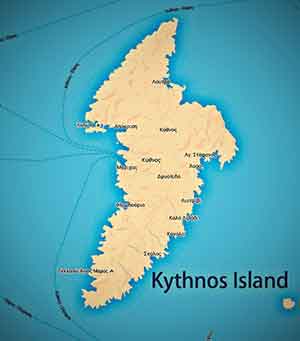
The image of windmills is inextricably linked in the minds of most visitors to the Cycladic islands and of course Kythnos is no exception to this rule. Windmills played a particularly important role in the economy of the Aegean islands and were used to grind flour. The Cyclades supplied flour and dry buiscuits to the merchant ships as well as the war fleets that crossed the Aegean and traveled to the Mediterranean and the Black Sea. In Kythnos we find windmills in Messaria as well as in Dryopida.
The construction of the Kythnos windmill
The windmills of Kythnos are circular constructions with an unknown date of construction and which are not in particularly good condition. The main body of the Kythnos windmill is made of stone while the mechanism is wooden and connected to two millstones. The movement of the mechanism is put into operation by the force of the wind. The island's windmills were made from stones found on the island while mud was used as mortar. The thickness of the walls reached 80 cm while the height of the windmill reached 6 meters. The stairs leading to the windmill lofts were on the left of the entrance while their direction is clockwise. Every windmill had a hearth and the whole equipment of the windmill was usually a stool and sometimes a bed. There were no cupboards as the essentials hung from the wall.
Windmills usually consisted of 3 lofts or floors as we would say today, with each loft performing its own function. The ground floor was where the sacks of barley were placed, that is to say, it was the storage area, while there may also have been the miller's rough bed. In the second was the steering wheel and only in case of lack of space were sacks of barley placed there. In the third loft, all the necessary work for the milling of the barley was done.
The roof was made of wooden elements on a slope on which rushes were placed. Fresh wood, mainly oleander, was placed around the rushes, and the whole structure was tied with wire.
The windmills of Dryopida
In Dryopida and at an altitude of 190 meters, the windmills of the area are found, which according to testimonies reached 26, but for the time being, the positions of only 20 of them have been identified. They were placed in groups around the settlement. Their positions were particularly good since the wind potential of the area is particularly strong. Two of these windmills have been restored, with one now housing a residence, with the effect of altering its features. The second one was restored to be used as a windmill but its use was abandoned. Of the rest of the windmills of Messaria Kythnos, two are still kept in good condition and one in moderate condition while the remaining 3 are in bad condition. At the same time there are still 8 windmills of which there are only traces or little remains.
The windmills of Messaria
In Messaria, at an altitude of about 150 meters, we meet some of the windmills of Kythnos which were built there to serve the residents since the wind potential of the area is not particularly strong. 17 windmills seem to have operated in the area, of which the positions of 16 have been identified. Unfortunately, the positions where the windmills were located were particularly "tempting" and as a result they were destroyed by the residents who took advantage of the positions and their construction materials.


























